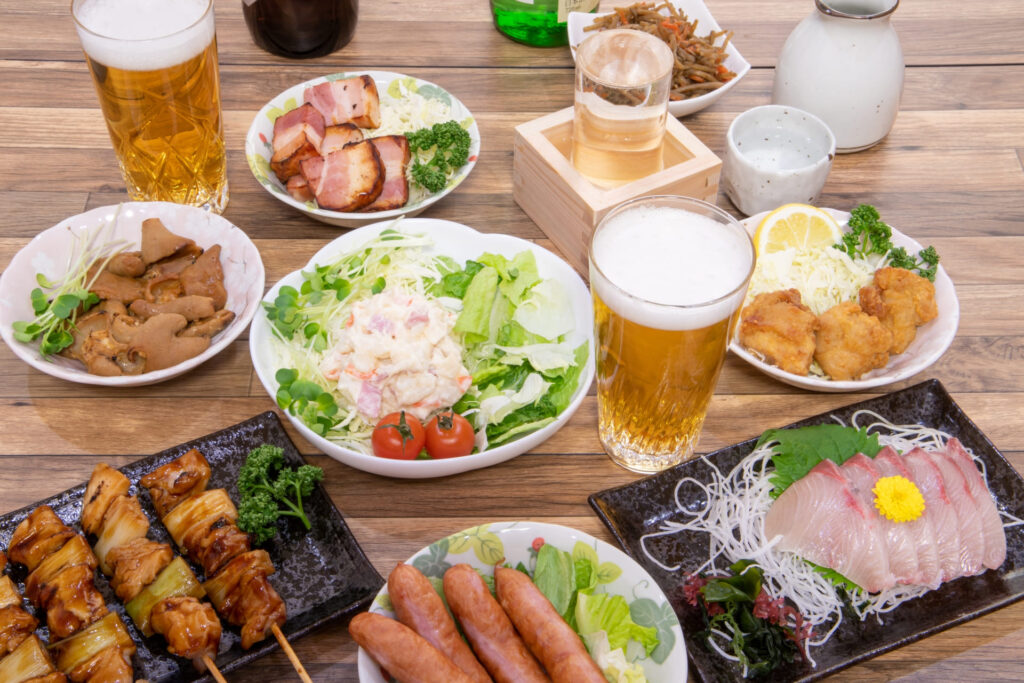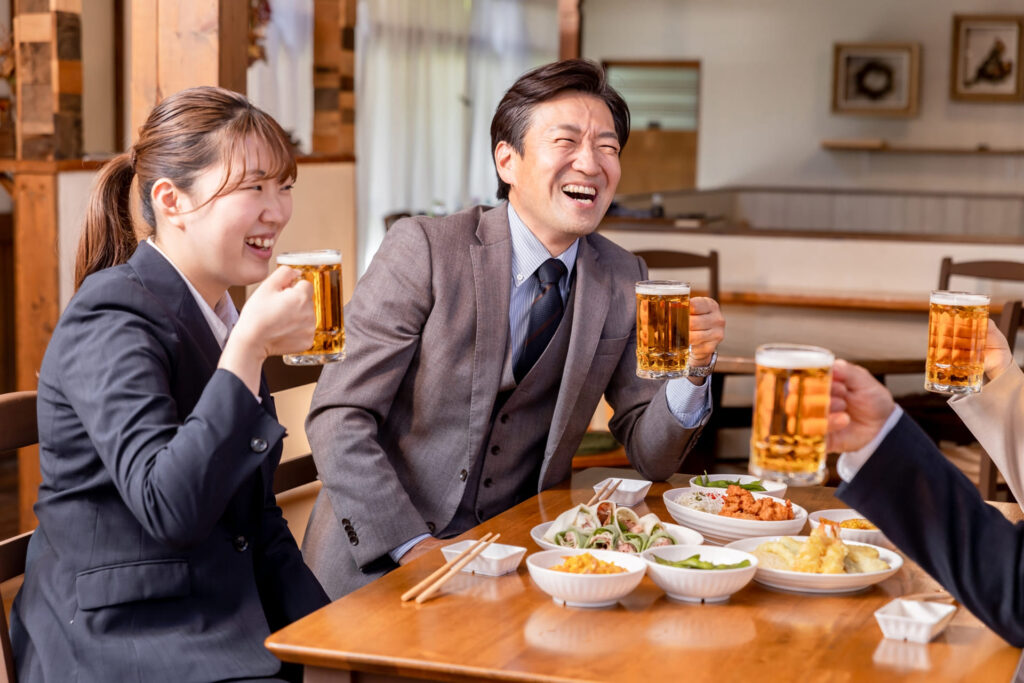Izakayas, like the British pub, are places where you can eat, drink, and most importantly, find reprieve after a day of work and responsibilities. They’re a cornerstone of Japanese nightlife.
Nowadays, Izakayas mostly fall into three categories: chain locations, independent izakayas, and themed bars.
There’s an abundance of izakayas to choose from, particularly concentrated around train stations. If you’re feeling adventurous, simply step into the closest izakaya around you; you might be pleasantly surprised by the offerings.
Izakaya Drinks and Dishes

Izakaya foods are served as small, shareable dishes such as sashimi, tempura, grilled meat, and vegetables. The small dishes are a major appeal as it allows you taste a variety of foods and flavors. Most izakayas have a variety of drinks that pair well with each dish. Staff at independent and modern izakayas can usually suggest which dishes and drinks best complement each other.
Sashimi is a popular dish plated artfully and surrounded with fresh, colorful vegetables and flowers. Sashimi is best paired with a light, fruity red wine, or a sake that has a similar clean, fruity taste to the fish.
Tempura is battered and deep-fried vegetables or seafood either simply dipped and eaten with sauce, rice, or noodles. Tempura has the perfect crispiness on the outside, and maintains the regular texture of the vegetables or seafood on the inside. Tempura is best paired with beer or a dry sake.
Yakitori and yakiniku are grilled meats dipped into or coated with a sweet and savory mix of soy sauce, sugar, and a sweet rice wine. Yakitori, or grilled chicken skewers, are a staple in many izakayas, available in numerous flavors and cuts. Yakiniku varies per izakaya and consists of either pork, beef, or lamb cut into bite-sized pieces either grilled by the chef or sometimes customers can enjoy cooking together while enjoying tall glasses of ice-cold beer. Other classic small dishes are edamame, gyoza, pickled vegetables, sliced tomatoes, fried eggs, and French fries, perfectly plated for sharing.
Chain Izakayas
Sometimes located in tall buildings and usually on the 2nd, 3rd, or 4th floors and up are chain izakayas. These izakayas are designed in a traditional Japanese style with a modern touch and are built to handle numerous customers and large groups. Opposed to independent izakayas, chain izakayas are impersonal – you are less likely to make friends with strangers as most people go there to meet up in groups. Filled with work colleagues, sports teams, old classmates, families, or just good friends getting together for a chat; chain izakayas are a bustling hub to grab fast eats.
The menu has dozens upon dozens of options usually on a computerized tablet with photos and an option to change the language, making it a perfect choice for picky eaters and international crowds. Ingredients often change with the seasons, showcasing the best of what’s available – so the menu may change often.
The drink menu has everything from chu-hi to sake and are offered at a very low price or a set price for all you can drink.
Independent Izakayas
Some small family-run izakayas can only accommodate three or four people at the time, and it’s in these cozy intimate places that locals come together after a busy day to chat, eat, and of course down a sake or two. The owner engages with patrons as they prep the food and pour the drinks, creating a personalized experience that you simply can’t recreate in a larger bar or restaurant.
It’s also in these places where the sense of community is the strongest. In a local izakaya, the customers are often on close terms with the owner, so when it’s close to full capacity non locals might be refused entrance to make space for more familiar faces.
Unlike chain restaurants, family-run or independent izakayas exist on local street corners usually away from train stations, tucked away in residential neighborhoods or even the first floor of the owner’s house. The décor has a simple at-home feel and the menu is either painted on wooden slabs or a large paper on the wall. The focus here isn’t on the surroundings but more on the foods, drinks, and connection between the locals who frequent those izakayas. It’s definitely a unique and exciting experience.
Modern Izakayas
Popular with younger crowds, the modern izakaya is a mix of an independent and a chain izakaya. The base décor has elements of old-style Japan such as menus which may be painted on wooden slabs, and posters of ads from the 1960’s, with the addition of modern light fixtures, furniture, and colorfully painted ceramic dinnerware. Some of these izakayas have cocktail bars or even live DJ’s.
Food options at a modern izakaya are a gourmet style fusion of western and Asian tastes. You are more likely to find pizza, fish drizzled with olive oil, chicken flavored with American-style BBQ sauces, and French fries sprinkled with cheese and herbs.
Drinks are carefully crafted by bartenders who use fresh seasonal fruits such as mango, or watermelon mixed with shochu. The lemon sour is one of the most popular drinks in Japan of which you can find almost anywhere. However, the modern izakaya creates a twist on the lemon sour by instead using different types of lemons and shochu with a sprig of mint, rivalling the standard taste.
Extensive Drink Selections
As soon as you enter some izakayas, you will notice an extensive line up of Japanese alcoholic drinks on the shelf. With a recommendation from the owner at an independent izakaya or bartender at a modern izakaya, or even from your skilled Best Experience Japan tour guide, you can find many distinct flavors to quench your thirst.
Alcoholic Beverages
- Sake and Shochu:
Izakayas typically offer a wide selection of sake and shochu, each with distinct flavors and brewing methods. The rice used for sake is specially grown for brewing. It goes through an extensive process of polishing, adding enzymes to convert the starch to glucose, and yeast then converts the glucose to alcohol. How much the rice is polished and the adding of the enzymes largely affect the aroma, flavor, and even the price of the sake.
The process of making shochu is a fascinating blend of tradition and creativity! It starts much like sake, but here’s where it gets interesting: sweet potatoes are introduced into the mix. The sweet potatoes are treated in a similar way to the rice, and they’re combined to create a truly unique and flavorful spirit. It’s like a fusion of two ancient techniques, resulting in something totally special!
- Beer and Cocktails:
Japan’s drink scene is a treasure trove of exciting choices, from local craft beers to inventive cocktails, there’s something for everyone to enjoy! Beyond the big names dominating the beer market, you’ll find dozens of locally brewed and craft beers scattered across the country. Japanese beers typically fall into two categories: malt beer, with a nice balance of malt content, and happoshu, which has a lighter malt profile for a crisp, refreshing taste.
When it comes to cocktails, Japan takes creativity to the next level with fruity mixes that burst with flavor. One of the most iconic drinks is the highball—a simple yet refreshing mix of whisky or vodka with soda water, tonic, or carbonated soda, topped with a zesty slice of lemon. Sours are another hit, with a kick from a hard spirit, sweetened by lemon or lime juice and sugar, and sometimes even a splash of seasonally picked citrus for that extra twist. And if you’re in the mood for a fizzy treat, go for a shandy (beer mixed with lemonade) or a shandy gaff (beer mixed with ginger ale)—perfect for a refreshing sip on a sunny day! Japan’s drink menu is anything but boring!
Cultural Significance

Culturally, meeting up with friends, coworkers, etc. at izakayas are a chance to socialize over affordable food and drinks, while melting away the stresses of work and/or life. For work colleagues, the izakaya is a place where you can get to know one another better, in hopes of become a stronger team in the office. For local regulars, it’s a way of supporting the owner who they have probably known for years, keeping up with news regarding each other, other neighbors, and what’s going on in their community. Above all, the izakaya is a place to deepen friendships and connections.
Some tips for you when you visit an izakaya:
Do not pour your own drink, always pour for others and make sure their glasses are not empty. When toasting, remember to say “kanpai” which means cheers. Most importantly, enjoy the delicious variety of foods and drinks offered and have fun! If you are wondering how to find izakayas with the best vibe, book a tour with Best Experience Japan and our guides will help you create your best izakaya experience!
Also, remember to check out our other articles on exploring Japan for the best foods and drinks.
